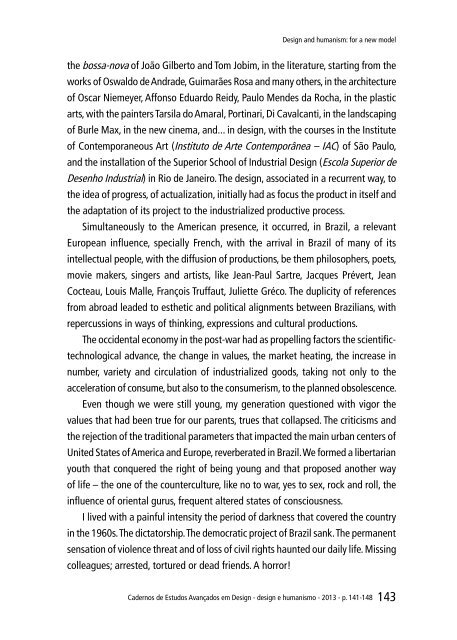o_19po8js951tvs1r0t1r8s4bb1vpla.pdf
Create successful ePaper yourself
Turn your PDF publications into a flip-book with our unique Google optimized e-Paper software.
Design and humanism: for a new model<br />
the bossa-nova of João Gilberto and Tom Jobim, in the literature, starting from the<br />
works of Oswaldo de Andrade, Guimarães Rosa and many others, in the architecture<br />
of Oscar Niemeyer, Affonso Eduardo Reidy, Paulo Mendes da Rocha, in the plastic<br />
arts, with the painters Tarsila do Amaral, Portinari, Di Cavalcanti, in the landscaping<br />
of Burle Max, in the new cinema, and... in design, with the courses in the Institute<br />
of Contemporaneous Art (Instituto de Arte Contemporânea – IAC) of São Paulo,<br />
and the installation of the Superior School of Industrial Design (Escola Superior de<br />
Desenho Industrial) in Rio de Janeiro. The design, associated in a recurrent way, to<br />
the idea of progress, of actualization, initially had as focus the product in itself and<br />
the adaptation of its project to the industrialized productive process.<br />
Simultaneously to the American presence, it occurred, in Brazil, a relevant<br />
European influence, specially French, with the arrival in Brazil of many of its<br />
intellectual people, with the diffusion of productions, be them philosophers, poets,<br />
movie makers, singers and artists, like Jean-Paul Sartre, Jacques Prévert, Jean<br />
Cocteau, Louis Malle, François Truffaut, Juliette Gréco. The duplicity of references<br />
from abroad leaded to esthetic and political alignments between Brazilians, with<br />
repercussions in ways of thinking, expressions and cultural productions.<br />
The occidental economy in the post-war had as propelling factors the scientifictechnological<br />
advance, the change in values, the market heating, the increase in<br />
number, variety and circulation of industrialized goods, taking not only to the<br />
acceleration of consume, but also to the consumerism, to the planned obsolescence.<br />
Even though we were still young, my generation questioned with vigor the<br />
values that had been true for our parents, trues that collapsed. The criticisms and<br />
the rejection of the traditional parameters that impacted the main urban centers of<br />
United States of America and Europe, reverberated in Brazil. We formed a libertarian<br />
youth that conquered the right of being young and that proposed another way<br />
of life – the one of the counterculture, like no to war, yes to sex, rock and roll, the<br />
influence of oriental gurus, frequent altered states of consciousness.<br />
I lived with a painful intensity the period of darkness that covered the country<br />
in the 1960s. The dictatorship. The democratic project of Brazil sank. The permanent<br />
sensation of violence threat and of loss of civil rights haunted our daily life. Missing<br />
colleagues; arrested, tortured or dead friends. A horror!<br />
Cadernos de Estudos Avançados em Design - design e humanismo - 2013 - p. 141-148<br />
143



